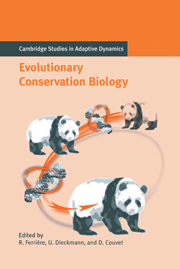Book contents
- Frontmatter
- Contents
- Contributing Authors
- Acknowledgments
- Notational Standards
- 1 Introduction
- Part A Theory of Extinction
- 2 From Individual Interactions to Population Viability
- 3 Age Structure, Mating System, and Population Viability
- 4 Spatial Dimensions of Population Viability
- Part B The Pace of Adaptive Responses to Environmental Change
- Part C Genetic and Ecological Bases of Adaptive Responses
- Part D Spatial Structure
- Part E Community Structure
- References
- Index
- The International Institute for Applied Systems Analysis
4 - Spatial Dimensions of Population Viability
Published online by Cambridge University Press: 15 August 2009
- Frontmatter
- Contents
- Contributing Authors
- Acknowledgments
- Notational Standards
- 1 Introduction
- Part A Theory of Extinction
- 2 From Individual Interactions to Population Viability
- 3 Age Structure, Mating System, and Population Viability
- 4 Spatial Dimensions of Population Viability
- Part B The Pace of Adaptive Responses to Environmental Change
- Part C Genetic and Ecological Bases of Adaptive Responses
- Part D Spatial Structure
- Part E Community Structure
- References
- Index
- The International Institute for Applied Systems Analysis
Summary
Introduction
In most parts of the world, habitat loss is the number one threat to endangered species. For instance, in Finland the primary cause of threat is some form of habitat loss or alteration in 73% of the red-listed species (Rassi et al. 2001). Typically, a reduced total area of habitat is accompanied by habitat fragmentation, such that the remaining habitat occurs in smaller fragments with reduced connectivity. Many landscapes for many species have become highly fragmented (the habitat fragments are small or relatively small and physically completely isolated), while other landscapes have always been highly fragmented naturally. Species that live in such landscapes necessarily have fragmented populations, which more or less closely approach the metapopulation structure originally envisioned by Levins (1969). Levins' metapopulation is a system of local populations that inhabit individual habitat patches connected, to some extent, by migration. The classic metapopulation concept assumes that local populations may go extinct, and so leave the respective habitat patch temporarily unoccupied, while the metapopulation as a whole may persist in a balance between extinctions and colonizations (Levins 1969; Hanski and Gilpin 1997; Hanski 1999). In a broader sense, any assemblage of local populations connected by migration can be called a metapopulation, regardless of the occurrence of local extinctions (Hanski and Gilpin 1997). What is important is the spatially localized interactions of individuals, which may significantly change the dynamics of the metapopulation as a whole in comparison with a single panmictic population (Hanski 1999).
- Type
- Chapter
- Information
- Evolutionary Conservation Biology , pp. 59 - 80Publisher: Cambridge University PressPrint publication year: 2004
- 1
- Cited by



